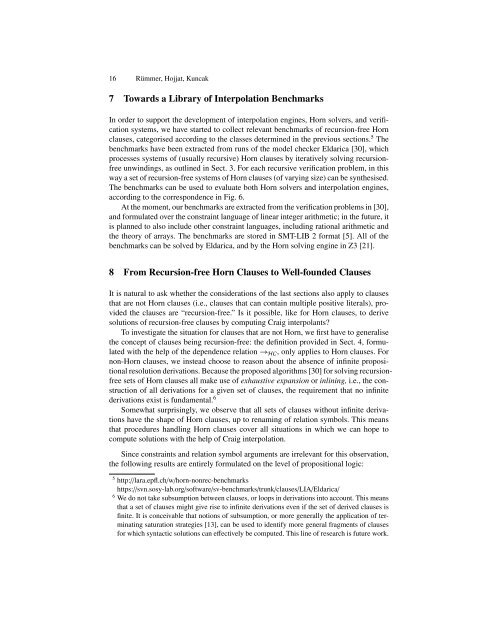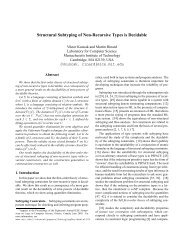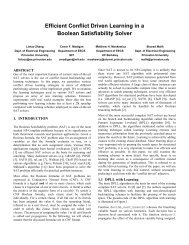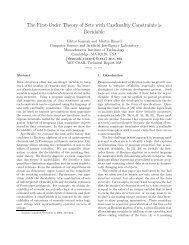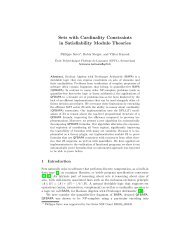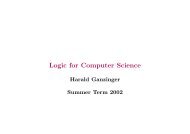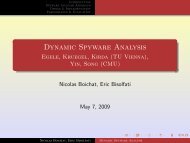Classifying and Solving Horn Clauses for Verification - Lab for ...
Classifying and Solving Horn Clauses for Verification - Lab for ...
Classifying and Solving Horn Clauses for Verification - Lab for ...
Create successful ePaper yourself
Turn your PDF publications into a flip-book with our unique Google optimized e-Paper software.
16 Rümmer, Hojjat, Kuncak7 Towards a Library of Interpolation BenchmarksIn order to support the development of interpolation engines, <strong>Horn</strong> solvers, <strong>and</strong> verificationsystems, we have started to collect relevant benchmarks of recursion-free <strong>Horn</strong>clauses, categorised according to the classes determined in the previous sections. 5 Thebenchmarks have been extracted from runs of the model checker Eldarica [30], whichprocesses systems of (usually recursive) <strong>Horn</strong> clauses by iteratively solving recursionfreeunwindings, as outlined in Sect. 3. For each recursive verification problem, in thisway a set of recursion-free systems of <strong>Horn</strong> clauses (of varying size) can be synthesised.The benchmarks can be used to evaluate both <strong>Horn</strong> solvers <strong>and</strong> interpolation engines,according to the correspondence in Fig. 6.At the moment, our benchmarks are extracted from the verification problems in [30],<strong>and</strong> <strong>for</strong>mulated over the constraint language of linear integer arithmetic; in the future, itis planned to also include other constraint languages, including rational arithmetic <strong>and</strong>the theory of arrays. The benchmarks are stored in SMT-LIB 2 <strong>for</strong>mat [5]. All of thebenchmarks can be solved by Eldarica, <strong>and</strong> by the <strong>Horn</strong> solving engine in Z3 [21].8 From Recursion-free <strong>Horn</strong> <strong>Clauses</strong> to Well-founded <strong>Clauses</strong>It is natural to ask whether the considerations of the last sections also apply to clausesthat are not <strong>Horn</strong> clauses (i.e., clauses that can contain multiple positive literals), providedthe clauses are “recursion-free.” Is it possible, like <strong>for</strong> <strong>Horn</strong> clauses, to derivesolutions of recursion-free clauses by computing Craig interpolants?To investigate the situation <strong>for</strong> clauses that are not <strong>Horn</strong>, we first have to generalisethe concept of clauses being recursion-free: the definition provided in Sect. 4, <strong>for</strong>mulatedwith the help of the dependence relation → HC , only applies to <strong>Horn</strong> clauses. Fornon-<strong>Horn</strong> clauses, we instead choose to reason about the absence of infinite propositionalresolution derivations. Because the proposed algorithms [30] <strong>for</strong> solving recursionfreesets of <strong>Horn</strong> clauses all make use of exhaustive expansion or inlining, i.e., the constructionof all derivations <strong>for</strong> a given set of clauses, the requirement that no infinitederivations exist is fundamental. 6Somewhat surprisingly, we observe that all sets of clauses without infinite derivationshave the shape of <strong>Horn</strong> clauses, up to renaming of relation symbols. This meansthat procedures h<strong>and</strong>ling <strong>Horn</strong> clauses cover all situations in which we can hope tocompute solutions with the help of Craig interpolation.Since constraints <strong>and</strong> relation symbol arguments are irrelevant <strong>for</strong> this observation,the following results are entirely <strong>for</strong>mulated on the level of propositional logic:5 http://lara.epfl.ch/w/horn-nonrec-benchmarkshttps://svn.sosy-lab.org/software/sv-benchmarks/trunk/clauses/LIA/Eldarica/6 We do not take subsumption between clauses, or loops in derivations into account. This meansthat a set of clauses might give rise to infinite derivations even if the set of derived clauses isfinite. It is conceivable that notions of subsumption, or more generally the application of terminatingsaturation strategies [13], can be used to identify more general fragments of clauses<strong>for</strong> which syntactic solutions can effectively be computed. This line of research is future work.


